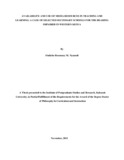AVAILABILITY AND USE OF MEDIA RESOURCES IN TEACHING AND LEARNING: A CASE OF SELECTED SECONDARY SCHOOLS FOR THE HEARING IMPAIRED IN WESTERN KENYA
Abstract
The use of media resources has an effect on students’ content acquisition as they add value to learning outcomes. However, research has shown that media resources cannot be effectively used unless they are available in sufficient quantities. Little attention has been given to the use of media resources in secondary schools for the hearing impaired. In view of this, the study sought to investigate the availability and use of media resources in the selected special secondary schools. The study was guided by five specific objectives: To determine if there is a significant difference between students’ and teachers’ perceptions on the availability and use of media resources for teaching and learning in schools for the hearing impaired in western Kenya; To assess the adequacy and frequency of availability and use of media resources in schools for the hearing impaired; To compare the pre-lingual and post-lingual students’ attitude towards the availability and use of media resources; To compare teachers’ and students’ attitudes towards the availability and use of media resources for teaching and learning in schools for the hearing impaired; To determine if there is an empirical relationship between the frequency of the availability and use of media resources and students’ content acquisition. The study was also guided by two theories, namely: Sweller’s (2005) Cognitive Load Theory, Dale’s (1969) Instructional Theory and Piaget’s (1964) Cognitive Development Theory. The study adopted a descriptive survey design. The target population was 498 respondents, comprising 3 principals, 40 teachers and 455 students and the sample size was 217 respondents consisting of 3 principals, 40 teachers and 174 students from the selected schools. Data were collected using questionnaires and observation check list. Test-retest method yielded Pearson product-moment correlation coefficients of 0.76, 0.78 and 0.71 for Principals’, teachers’ and students’ questionnaires hence were considered reliable. Descriptive statistics such as frequency counts, percentages and weighted averages were used to analyze findings of respondents’ views. The Chi-square test was used to test for independence of responses between Pre and post-lingual students and between teachers and students. Simple linear regression analysis was used to determine the relationship between students’ attitude and level of content acquisition while Binary Logistic regression was used to determine the relationship between frequency of use of media resources and content acquisition. SPSS version 21 and STATA were used to generate the required statistics for analysis. Results were presented using tables and charts. The study established that chalkboards, Science labs, Textbooks, Specimens, Maps, Atlases, Graph papers and Charts were available but were not adequate and were old and unusable. The use of electronic media such as computers, overhead projectors and videos was inadequate despite the rapid technological change and this was attributed to non-availability, inaccessibility and lack of requisite training. A significant difference in attitude towards the use of media resources between pre-lingual and post-lingual hearing impaired was established ( = 4.0816, p< 0.05). However, there was no statistically significant difference in attitude towards the use of media resources between teachers and students ( = 0.8556, p> 0.05). Further, a positive relationship between frequency of use of media resources and content acquisition was established. The study recommends that the ministry of education through the quality Assurance office increases the frequency of inspection in public secondary schools for the hearing impaired to ensure compulsory use of media resources in the teaching process besides adequately financing their development or purchase and providing in-service training to the teachers so as to enhance their ability to effectively use media resources.

